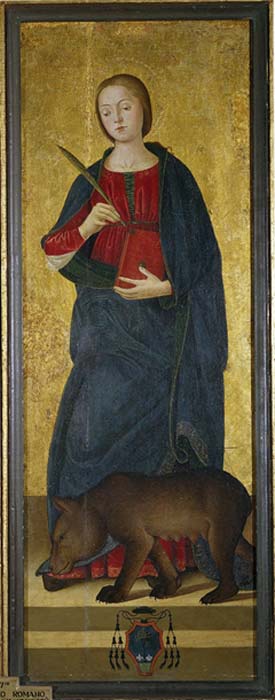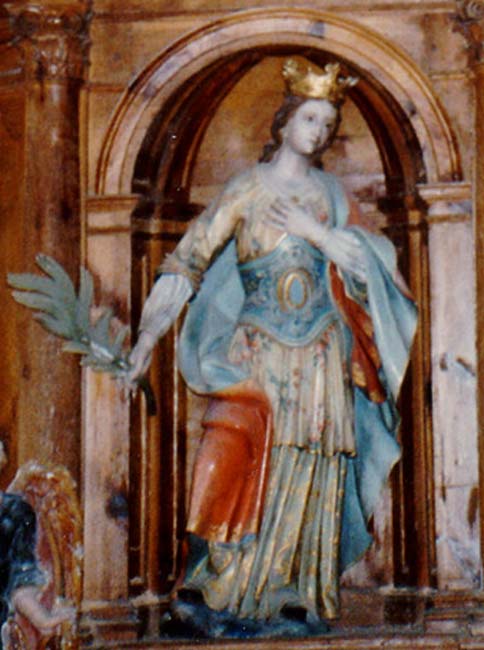
Saint, Witch or Both? The Strange Case of St Columba of Sens
The cult of St Columba is connected to France, where she died. She was beheaded in Sens - the major center of her cult now. However, while French religious people pray to the historical figure as an iconic saint, hundreds of kilometers from Sens there are people who worship her as a witch.
St Columba was probably born in the current territory of Spain, but her life, death, and cult is mostly associated with France. However, specialists in the lives of saints suggest that Columba of Sens is the same woman as Columba of Spain, who lived during the 9th century AD. The French saint is known as a very different person in some regions of Spain.
The St Columba cult is very strong in France and connected with a specific story, thus linking her with the Spanish woman may be a misinterpretation. There is also a possibility that the legend of Columba of Spain was just another way to stop the cult of women who were seen as dangerous for the Church.

Saint Columba with a bear. (hartzulo)
The Legend of Saint Columba the Martyr
According to the popular Christian legend, St Columba was a martyr who was murdered by the Roman Emperor for her beliefs and disagreements about pagan domination. Her original name was probably Eporita, and she was a member of a very influential noble family. Her relatives worshiped the old deities and didn't follow the new religion. Members of her family were some of the most important people related to the Roman Empire.
When she was 16 years old, she decided to leave her homeland and go to the region of modern Vienna, where she was baptized and received the name Columba or Comba. The legend of St Columba says that when Emperor Aurelian wanted to arrange the marriage of his son with Columba she refused. For her disobedience, Aurelian decided to close her in the brothel of the amphitheater, which is known in Christian literature as a place used by the Roman Empire for torturing and killing Jesus’ followers.
While Columba was imprisoned, someone tried to rape her, but the legend says she was saved by a she-bear. Aurelian was furious and decided to burn the animal and Columba together, but the bear escaped and survived. Moreover, the legend says that God sent rain, stopping them from starting the fire. Therefore, Columba was beheaded instead. The execution took place next to a fountain known as the fountain d'Azon. Later, people recovered her body and buried her in a grave, which is now under the famous Abbey of Sens.

St Colomba Saved by a Bear. (1340s) By Giovanni Baronzio. (Public Domain)
Although the story may not convince anyone who has a deeper knowledge of the Roman Empire, it survived for centuries and became the basis for the huge cult dedicated to this woman seen as a symbol of innocent virgins and martyrs.
- Gone and Forgotten: The Sad Fate of the Witches of Prussia
- Archaeologists Identify Scottish Church Where Accused 16th Century Witches Were Imprisoned
- Saint Augustine of Hippo and His Detours on the Long and Winding Path to Christianity

Main altar of Église Saint-Colombe, Hattstatt, France. The statue on top depicts Columba of Sens. (Ralph Hammann/CC BY SA 4.0)
The Spanish Witch
The cult of Saint Columba or Comba flourished during the Middle Ages, but Allyson M. Poska, a researcher and author of the book ''Women and Authority in the Early Modern Spain. The peasants of Galicia'', found another version of the story. Although Christianity believes that Columba was a martyr, the old Galician resources reveal a different story. According to Poska, the woman known as a saint from Sens was none other than a famous witch in Spanish Galicia. As she wrote:
''Across Galicia, St Comba is known as the patron saint of witches, a curious notion in and of itself. On the one hand, she acts as an intercessor on behalf of witches, while on the other hand, people go to her to defend themselves against witches. One informant told Marisa Rey-Henningsen, ‘there . . . you can see she was a great witch, and now she is the greatest of saints.’ Even today, Galegos remain comfortable with both the positive and negative connotations of having witches in their midst.''

Santa Columba at Santa Coloma, in Arceniega (Álava, Spain). (Public Domain)
The Galician version of the legend about the saint says that St Columba was a witch who met Jesus Christ on the road. He told her that she would not enter his kingdom, so she decided to change her life. However, it seems that she remained a witch while being a Christian. This was a common mixture in the early times of Christianity.
- Why Did the Spanish Inquisition Allow Some Witches to Stay Alive?
- Exploring the Famous Legend of St. George and the Dragon
- The Biblical Witch of Endor: Contacting the Spirit of a Prophet
During the first centuries of Christianity and even medieval times, it was quite common for women who were witches to try to enter safe places like monasteries. These witches weren't what the newly growing religion wanted them to be. They were well educated women, who knew about nature and had skills to help and heal. With the appearance of the new monotheistic religion the tradition of witchcraft lost its place. Many of these women wanted to continue cultivating the ancient wisdom no matter what, so they joined safe places where they could plant their herbs and spend time with books – in the convents of the nuns.

Painting titled ‘Saint Catherine of Siena writing’ (1630s) by Rutilio di Lorenzo Manetti. (Public Domain)
Searching for the Real Columba
The remains of St Columba were supposedly destroyed by the Huguenots during the 16th century. Without her bones it is impossible to verify the information about her origins, age, etc. In fact, apart from the two different stories there is no evidence of her existence.
St Columba is not only the patron of witches, but also the rain, and thus she is connected with nature. She is always presented with an animal and/or a plant. This iconic person remains a bridge between two different worlds – Christianity and pagan witchcraft.

Statue of Santa Columba. (Ralph Hammann/CC BY SA 4.0)
Top Image: Representation of Santa Colomba (Saint Columba) by Pellegrino da San Daniele. Source: YukioSanjo/CC BY SA 3.0
References:
Allyson M. Poska, Women and Authority in the Early Modern Spain. The peasants of Galicia, 2005.
Saint Columba, available at:
http://web.archive.org/web/20150109160556/http://saints.sqpn.com/saint-columba-of-sens/
The church of St Colomba, available at:
http://spazioinwind.libero.it/iconografia/Colombainglese.htm
St Columba, available at:
http://www.newadvent.org/cathen/04135b.htm















Comments
Strange how the ‘church’ still builds shrines to people they’ve executed for heresy. But I guess it brings in lots of money.
One has to be aware of the life of Hildegard of Bingen who was one of those educated women and aware of a lot more than just nature. She was so well accepted she travelled freely in Germany (it was not a country but a conglomerate of duchies)
Si vis pacem, para bellum